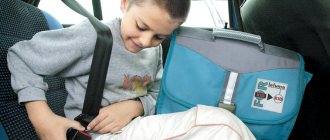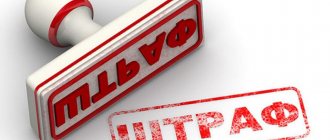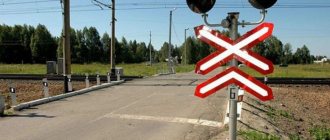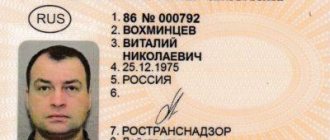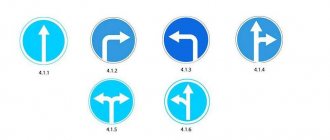What is the penalty for violating traffic rules?
In big cities, violating the rules of driving through intersections is not uncommon. But this does not mean that it is possible to do so. When entering an intersection, it is worth assessing the situation with utmost attention - if the driver behaves incorrectly, he cannot leave it and creates a problem for traffic flows. If you drive through intersections incorrectly, a fine will be imposed according to Article 12.13 of the Code of Administrative Offenses.
In the Rules, an intersection is considered to be an area where roads located at the same level intersect, adjoin each other or branch. The area should be limited by imaginary lines that connect the starting points of the curvature of the roadways, most distant from the middle of the intersection.
Departure in case of congestion
According to Article 12.13 of the Administrative Code , attempting to enter an intersection in the event of a traffic jam directly behind it constitutes an administrative offense and is punishable by a fine of 1,000 rubles. The driver's behavior in this situation is specified in the traffic rules very clearly. You can read more about traffic police fines in the amount of 1000 rubles in this material.
When trying to enter a road intersection, not paying attention to the fact that there is a whole line of cars standing outside, the offender gets stuck in the most inconvenient place on the road. It is precisely where he will be forced to stop the vehicle that an increased danger for the offender is expected; in addition, in this case it becomes an obstacle to the movement of cars from other directions.
It is also worth remembering that as of April 28, 2018, a new road sign and horizontal markings for intersections appeared:
- 1.26 - the so-called “waffle” horizontal marking, prohibiting crossing in case of congestion at the intersection;
- 1.35 — sign “Crossroads section”. Placed at the border of the intersection.
Horizontal marking 1.26
Sign 1.35 “Intersection Section”
What happens if you don’t give way to another car?
When driving through intersections, you must give way to cars approaching from the right , if we are talking about an unregulated option. If a car, which in this situation will have the right of way, cannot pass due to the driver’s reluctance to let it through to perform the maneuver, the violator will face a fine of 1,000 rubles (Article 12.13 of the Administrative Code).
Reversing
Important! At intersections, the vehicle driver is prohibited from driving in reverse.
The ban is associated with the increased danger of any maneuvers on these sections of roads. For violating the rules of maneuvering, a fine of 500 rubles is imposed (more details about traffic police fines in the amount of 500 rubles can be found here).
It is worth remembering that when trying to move in this way at a road intersection, if the driver has passed the entrance to the yard, the maneuver will be considered permitted. The traffic rules indicate that leaving the yard does not fall into the category of intersections .
Grounds for imposing a fine
There are several factors in the rules of the road that can cause you to run a red light. Let's talk about them in more detail.
Leaving and stopping at an intersection due to a traffic jam
If the driver of the vehicle entered the intersection at the moment when there was a traffic jam in front while the traffic light was permissive, and a second later it changed to prohibiting, it turns out that the driver will stand in the middle of the intersection without the opportunity to reverse (after all, there are already cars there).
Thus, he creates a traffic obstruction not only for his line, but also for those cars whose light is green. The motorist will need to go through a red light as soon as the cars in front move forward, which will certainly entail a fine of 1000 and the deprivation of his license in the future if this situation does not teach him anything.
Unfortunately, this situation on the road happens everywhere. This phenomenon is due to the fact that many drivers simply do not know what to do.
To make the situation easier for car drivers, here are two factors that must be present when crossing an intersection:
- Green light.
- There is no car immediately after the intersection.
Crossing the stop line at a traffic light
This line is indicated by road markings. It can be located either at a traffic light, a traffic controller at an intersection, or in front of a sign that prohibits movement without stopping.
If you stop for it in the near future, you can expect a fine. The fine may be slightly lower - 800 rubles. You can enter legally only when you cannot do without emergency braking.
Features of travel at a railway crossing
If a clearly red traffic light is visible at a railway crossing, passage is strictly prohibited by traffic regulations. Such a violation is punishable by deprivation of rights for up to 6 months and a payment of 1,000 rubles.
Please note that security cameras are very often located in such areas. You shouldn’t risk your own life or create an accident to save a couple of minutes.
Multiple red light violations
If within one year after paying the first fine for running a red light, the driver repeats the same offense, then the penalty increases. If during this period of time a motorist passes a prohibitory signal three times, the inspectorate has the right to draw up a protocol for deprivation of rights for 4 to 6 months.
In this case, the period when a fine can be received as a repeated one begins from the time the driver’s license is handed over. The repeated fine payment for 2021 is 5 thousand rubles.
The concepts of equivalent and unequal
By ignoring traffic regulations, motorists interfere with all vehicles in the neighborhood. Therefore, it is worth not just familiarizing yourself with the established provisions once, but also making it a rule to repeat them from time to time. When driving through such intersections, it is recommended to maintain distance. The optimal value is considered to be 50 meters - this allows even inexperienced drivers to assess the situation in advance and make the right decision.
Unregulated
At controlled intersections, traffic is carried out in accordance with the traffic lights or those given by the traffic controller (more information about driving through a prohibitory traffic light can be found in this material). In case of a controversial situation, the signals given by the regulators will have priority.
Vehicles can travel in directions permitted by a traffic controller or a special green signal. When turning left, the driver lets through all vehicles that are going to drive in the straight direction or turn right.
When driving through road intersections where there are no traffic lights or traffic controllers, you should use the right-hand rule. According to clause 11 of article 13 of the traffic rules, drivers of trackless vehicles must give way to everyone driving from the right side of an equivalent intersection. The same rule applies to tram drivers. When moving to the left or making a U-turn, you should give way to cars and trams that are traveling on an equivalent road from the opposite direction to the right or straight (clause 12, article 13).
When approaching an unregulated intersection on a secondary road, a motorist allows everyone driving on the main road to pass. Those driving along the main road use the right-hand rule to establish queues.
Circular
Intersections with roundabout traffic are always unregulated. But they can be equivalent or unequal. It is worth remembering that cars driving in a circle are automatically considered to be on the main road. When driving through an unequal roundabout intersection, follow the signs.
Attention! A driver entering such an intersection must always turn on the right turn signal. It is turned on before leaving. You can enter the intersection from any of the lanes, but you must exit from the right.
Tram rails
Clause 6 of Article 13 of the Traffic Regulations states that the tram will always have the right of way over trackless vehicles . Exceptions are when a tram leaves a depot, moves to a switch in an additional section of a traffic light, or approaches an intersection of roads with a secondary one.
In general, intersections are sections of roads located at the same level, which can intersect each other, split into several parts, or converge at one point. According to the rules, you cannot enter an intersection if there is a traffic jam behind it (clause 2 of article 13 of the traffic rules). This concept is not deciphered in any way in the traffic rules. It is assumed that a traffic jam can be defined as several vehicles stopped on the road without violating the rules.
A classic traffic jam can be described as follows: it is several vehicles accumulated on the roadway, moving at extremely low speeds or even standing in one place. Its formation reduces the capacity of the road section. Congestion increases when other vehicles join it.
Commentary on Article 12.13 of the Code of Administrative Offenses of the Russian Federation
1. In accordance with the Rules of the Road, an intersection is understood as a place where roads intersect, adjoin or branch at the same level, limited by imaginary lines connecting, respectively, the opposite, most distant from the center of the intersection, beginnings of curvatures of roadways. Exits from adjacent areas are not considered intersections.
According to Art. 2 of the Federal Law of December 10, 1995 N 196-FZ “On Road Safety”, as well as clause 1.2 of the Traffic Rules, a road is understood as a strip of land or a surface of an artificial structure that is equipped or adapted and used for the movement of vehicles. The road includes one or more carriageways, as well as tram tracks, sidewalks, shoulders and dividing strips, if any. Within the meaning of the Road Traffic Rules, a carriageway is an element of the road intended for trackless vehicles.
According to clause 13.3 of the Traffic Rules, an intersection where the traffic order is determined by traffic lights or traffic controller signals is considered regulated.
If there is a flashing yellow signal, non-functioning traffic lights or the absence of a traffic controller, the intersection is considered unregulated and drivers are required to follow the rules for driving through uncontrolled intersections and the priority signs installed at the intersection.
The procedure for driving through controlled and unregulated intersections is determined according to clauses 13.4 - 13.8, 13.9 - 13.13 of the Traffic Rules (clause 13.9 as amended by Decree of the Government of the Russian Federation of September 25, 2003 N 595).
Within the meaning of Part 1 of the commented article, a forced stop of a vehicle should be distinguished from its deliberate stop (see paragraph 2 of the commentary to Article 12.10).
2. The driver of a moving vehicle that has resumed movement, carrying out any maneuver at an intersection, forcing the driver of a vehicle enjoying the right of priority passage through the intersection to change direction or speed, commits an administrative offense provided for in Part 2 of the commented article.
In accordance with paragraphs 13.9 - 13.11 of the Traffic Rules, at the intersection of unequal roads, the driver of a vehicle moving on a secondary road must give way to vehicles approaching on the main road, regardless of the direction of their further movement.
In the event that the main road changes direction at an intersection, drivers moving along the main road must follow the rules for driving through intersections of equivalent roads. Drivers driving on secondary roads should follow the same rules.
At an intersection of equivalent roads, the driver of a trackless vehicle must give way to vehicles approaching from the right. Tram drivers should follow the same rule among themselves.
At such intersections, the tram has priority over trackless vehicles, regardless of the direction of its movement.
3. On the consideration of cases of administrative offenses provided for in the commented article, see paragraph 5 of the commentary to Art. 12.12.
4. On the collection of an administrative fine in cases provided for in Part 1 of the article in question, see paragraph 7 of the commentary to Art. 12.1.
Controversial situations
It is not uncommon for controversial situations that force traffic violations to occur due to improper traffic organization. For example, a main road sign may be placed at an exit from an adjacent area, but such a road crossing is not considered an intersection. A driver who has been misled and received a fine for an incorrect assessment of the situation is recommended to especially point out during the proceedings the fact that traffic on the road is organized incorrectly.
It is not uncommon for traffic police inspectors to try to mislead drivers by implying that they stopped incorrectly before passing through an intersection. Meanwhile, the driver is sure that he stopped exactly in front of the stop line and did not enter the intersection. Unless the violation was recorded using photos or video, try to prove that the stop was made correctly. In practice, the location of traffic police officers rarely makes it possible to accurately determine whether the car was stopped correctly.
Reference! To prove the guilt of drivers, traffic police inspectors can use photographs or video materials taken directly at the scene of the violation.
Witness testimony taken at the scene of the violation is used less frequently. It is not always possible to organize them.
Punishment for violation
Entering an intersection may occur in violation of various traffic rules and regulations. Depending on this, the article of the Code of Administrative Offenses regulating punishments, as well as the wording of the punishment, will change.
For leaving during congestion
The conditions of punishment for violating the procedure for moving vehicles through a difficult intersection are regulated by Article 12.13 of the Administrative Code.
In accordance with this article, a driver who violates traffic rules for entering or crossing an intersection will be fined 1,000 rubles. However, in fact, in large cities, traffic police officers rarely stop drivers for such violations. If the driver makes a trip that is dangerous and can lead to an accident, then he will be stopped, but the amount of the fine will be several times higher. Therefore, the driver does not need to rush to enter an intersection clogged with cars, so as not to aggravate the already difficult situation on the road.
Surely a fine will be issued if a violation of the rules for driving through an intersection was recorded by a video recording device. In this case, the offender will not be able to avoid punishment.
What violations are recorded by traffic police cameras?
The punishment will be similar for maneuvering at an intersection where a car that has the right of way has already left. This is discussed in Part 2 of Article 12.13 of the Administrative Code.
If an accident occurs due to the fault of the offender, the fine will be much higher. Here everything will depend on the extent of the damage and the presence of injured persons.
A penalty of 1,000 rubles also awaits the driver who entered the intersection during a traffic jam. Moreover, a traffic jam is not a traffic jam, in the usual sense of the word, but even 1-2 cars located at an intersection. Therefore, if the driver sees that there is a car at the intersection, then there is no need to rush to the intersection of roads. It is advisable to wait until cars leave the intersection and only then enter it.
For running a red traffic light
A vehicle that enters an intersection at a red light poses a particular danger to other road users. Drivers who drive on a green signal do not expect that the car can drive on a prohibited signal and may simply not have time to react to the creation of an emergency situation.
Dear reader! Didn't receive an answer to your question? Our expert lawyers work for you. It's absolutely free!
- Moscow ext 152
- St. Petersburg ext 152
- All regions ext 132 (Toll free)
Fine for driving through a red traffic light
The punishment for this offense is determined by part 1 of article 12.12. The amount of the penalty will depend on whether the driver has previously violated traffic rules under this article:
- The fine issued for the first time will be 1,000 rubles;
- If the violation is repeated within a year, the driver will be fined 5,000 or will be deprived of the opportunity to drive a car for up to six months.
If this violation is detected by photo and video recording devices, the violator will only face a monetary fine. In this case, deprivation of rights is not provided.
In addition to the above violations, drivers can make the following mistakes while driving through an intersection:
- Find yourself in the oncoming lane (the fine will be 5,000 rubles or your driver’s license will be revoked);
- Stopping at a zebra crossing, creating an obstacle for pedestrians (punishment – 1,500 rubles);
- Cross the stop line posted before entering the intersection (the fine amount will be from 500 to 800 rubles).
